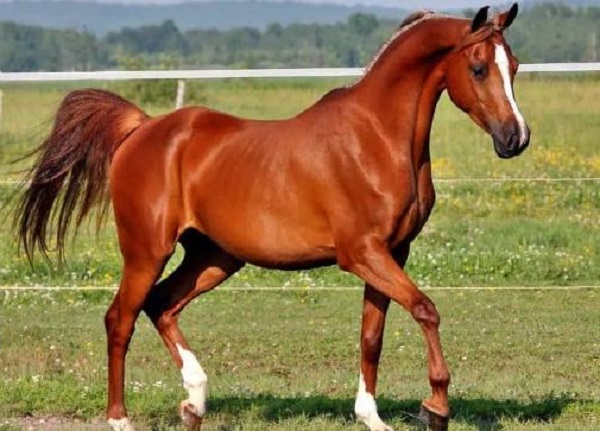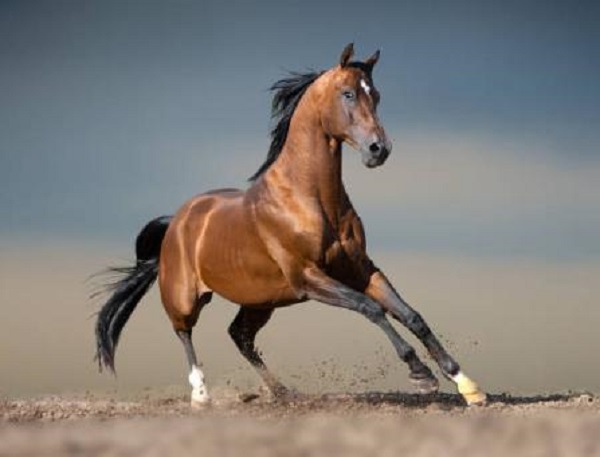Dive into the timeless allure of the Arabian horse breed with our article, “Arabian Horse: Unveiling Distinctive Characteristics and Breed Profile.” Spanning millennia, these majestic horses are celebrated for their beauty and calm temperament. Recognized by unique features like a distinct head shape and expressive eyes, Arabians have not only shaped their own breed but have also influenced various light horse breeds. Join us in exploring the captivating world of Arabian horses, discovering the traits that make them enduring symbols of grace and excellence in the equestrian realm.

The origins and history of the Arabian horse
The history and genesis of the Arabian horse may be traced back to the region around the Arabian Peninsula, immersed in the enigmatic aura of ancient deserts. These horses, whose origins are thought to date back to around 3000 B.C., were an essential component of Bedouin tribes’ cultural legacy, and their detailed pedigrees documented their common past. The hardiness of the breed was refined over ages as it adapted to the severe desert environment and topography.
When Arabian horses were first used as war horses, load-bearing, and transportation animals, they were so highly valued that some of them were taken inside family tents at night for safety and warmth.
Arabian horses traveled beyond the Arabian Peninsula as time passed, carried by the tides of commerce and conflict into Europe and other continents. Famous people from history, such as Alexander the Great, George Washington, Napoleon Bonaparte, Genghis Khan, and Napoleon, were enthralled with Arabian horses and proud owners of them. The prophet Mohammed personally stressed the need of showing love and respect to Arabian horses.
In the 1700s, the Arabian horse began a new chapter in its worldwide adventure when it arrived in the United States. The Arabian Horse Registry of America was founded in 1908, confirming the breed’s existence in the country and attesting to the magnificent animals’ long tradition and broad impact.
Arabian horse characteristics

The distinctive look and distinguishing features of Arabian horses, a combination of features that contributed to the breed’s extraordinary beauty and helped them survive in the desert, set them apart.
After decades of careful breeding, the unique qualities that made the Arabian such a valuable warhorse have developed into a clever and adaptable riding partner for modern riders. Though they were historically excellent in endurance races, Arabians are also good mounts for pleasure riders in a variety of other disciplines, demonstrating their versatility. As beloved companions and durable athletes, Arabian horses continue to leave a lasting heritage that unites the past and present.
About appearance
Arabian horses, ranging from 14.1 to 15.2 hands, boast a smaller and lighter build. Despite their size, they are officially classified as horses rather than ponies. Iconic features include refined heads, broad foreheads, dished faces, large expressive eyes, and small muzzles. The distinctive forehead bulge, known as the jibbah, aids in sinus capacity and temperature regulation.
An ideal Arabian showcases an arched neck, a well-set windpipe, and a clean throatlatch, allowing flexibility in the bridle and ensuring comfortable breathing. Additional traits include a long, level croup, high tail carriage, short, straight back, and well-sprung ribs. Some may have fewer lumbar vertebrae and pairs of ribs. Short cannons and robust feet contribute to overall soundness, emphasizing the breed’s distinctive appearance.
Colours
The AHA registers Arabians in five main coat colors: Gray, Bay, Chestnut, Black, and Roan. Purebred Arabians lack dilution genes for dun, cremello, or buckskin colors, which are only found in crossbreds. Some Arabians may carry a mutated dilution gene associated with Lavender Foal Syndrome.
Though ancient Egyptian art hints at spotting patterns in ancestral Arabian-type horses, modern Arabians generally lack pinto and leopard complex patterns. Except for the skin under white markings, all Arabians have black skin for desert sun protection.
The temperament
Unjustly thought of as high-strung, Arabians really have a temperament that has been shaped over generations of breeding for bravery and devotion. Unwanted actions are often the result of mistreatment, notwithstanding their intellect, sensitivity, and vivacious temperament.
Arabians are brave and devoted horses that make wonderful riding companions for the proper rider. Beginners may have difficulties, nevertheless, due to their lively disposition.
Because they have a long history of human contact, many Arabians have excellent temperaments by nature. But just like any horse, they might be tense or anxious sometimes. To fully realize these amazing horses’ potential, proper handling and knowledge are essential.
Looking after Arabian horses
Recognizing the athletic potential and endurance-focused background of Arabian horses is essential to their care. These horses thrive in a variety of activities, from beautiful dressage to exciting racing performances, thanks to their compact bodies that provide strength and balance. Because Arabians play a variety of functions in the entertainment industry, on ranches, and in show rings, it is imperative that their well-being be taken care of. Knowing these amazing horses’ past and physical characteristics helps to ensure that they have happy and healthy lives.

Diet and Nutrition
Arabian horses need a well-balanced diet that includes enough water, minerals, vitamins, proteins, fats, and carbs to be healthy. As with other horse breeds, Arabians are fed fresh grass, premium hay, grains, and sometimes sweets like fruits and vegetables. Arabians may need a little less food to stay at a healthy weight than horses that are comparable in size because of their desert heritage. For the sake of their wellbeing, it is important to strike a balance between overfeeding and providing enough nutrients.
Grooming
Following accepted equestrian grooming procedures is necessary to preserve Arabian horses’ health. Frequent brushing helps keep perspiration and oils in check for a healthy coat and skin, especially after activity. Their tail and mane stay smoother when they use a detangler. Daily hoof washing is also necessary to maintain the health of their hooves, and regular inspections aid in spotting any problems and providing timely medical attention. Arabian horses’ general health and attractiveness are enhanced by regular brushing.
Arabian horse health issues
Numerous health problems that affect Arabian horses may be attributed to hereditary reasons. The severity of these ailments varies; they include both curable and potentially lethal conditions. Arabian horses may have a number of noteworthy genetic diseases, including:
- Severe Combined Immunodeficiency (SCID): These foals are very susceptible to illnesses since they are born without an immune system. Unfortunately, since foals with SCID usually die quickly from infections, the prognosis is frequently dismal.
- Lavender Foal Syndrome: A variety of neurological problems may arise from this neurological condition, which first appears in foals. Regrettably, Lavender Foal Syndrome often results in a fatal prognosis for foals afflicted.
- Cerebellar Abiotrophy: A neurological condition that impairs a foal’s coordination and balance, Cerebellar Abiotrophy may have life-threatening repercussions and often ends in death.
Notwithstanding these inherited tendencies, Arabian horses are renowned for being amiable toward people. If not treated appropriately, their sensitivity and intellect might lead kids to develop bad behaviors. Although these horses may reject inadequate training techniques, they often prove docile and controllable for handlers with the requisite experience and competence. To assist lessen the effects of these genetic illnesses and preserve the health and well-being of Arabian horses, regular veterinarian care and genetic screening are crucial.
The Arabian horse’s lifespan
The Arabian horse typically boasts a lifespan of 25 to 30 years, although some individuals can live even longer with proper care. Factors influencing their longevity include genetics, diet, living conditions, and overall health maintenance. Arabian horses are known for their hardiness and resilience, and with attentive care, they often enjoy a relatively extended and active life. Regular veterinary check-ups, balanced nutrition, appropriate exercise, and a suitable living environment contribute to ensuring the well-being and longevity of these remarkable horses.
Why the Arabian horse is so popular
The Arabian horse’s ongoing appeal stems from its extensive heritage, superior genetics, and adaptable characteristics. Arabian horses are notable for having served important historical leaders like Alexander the Great and Napoleon Bonaparte. Their popularity is largely due to their versatility in a range of sports, including endurance riding and racing. Notable horses from literature and film, such as Cass Ole from “The Black Stallion,” have added to the breed’s appeal. With its unique appearance and outgoing personality, the Arabian horse never fails to wow horse aficionados, cementeding its place as a cherished and in-demand breed.
Prices of Arabian horses
Arabian horses are generally priced between $5,000 and $20,000 on average. The cost can vary based on factors such as prestigious bloodlines and rare coat colors, with some individuals commanding considerably higher prices. Given the popularity of the breed, Arabian horses are commonly found at reputable horse rescues or from breeders.
Conclusion
The Arabian horse stands as a timeless symbol of grace, versatility, and historical significance. From their distinctive physical features to their enduring popularity, these remarkable equines continue to captivate enthusiasts worldwide. Whether gracing the pages of history, starring in films, or participating in various equestrian disciplines, the Arabian horse remains a testament to its enduring appeal and unique contributions to the world of horses.
